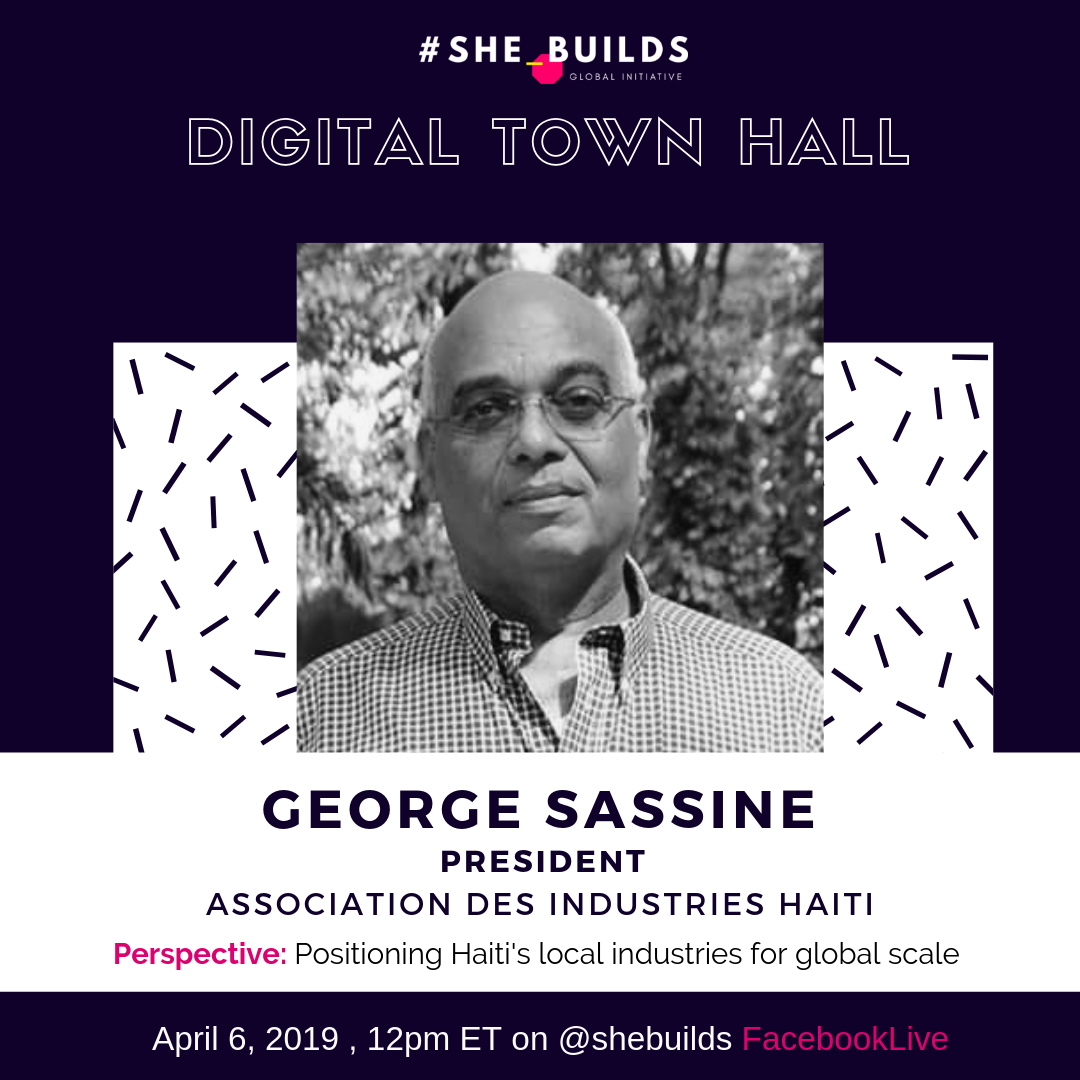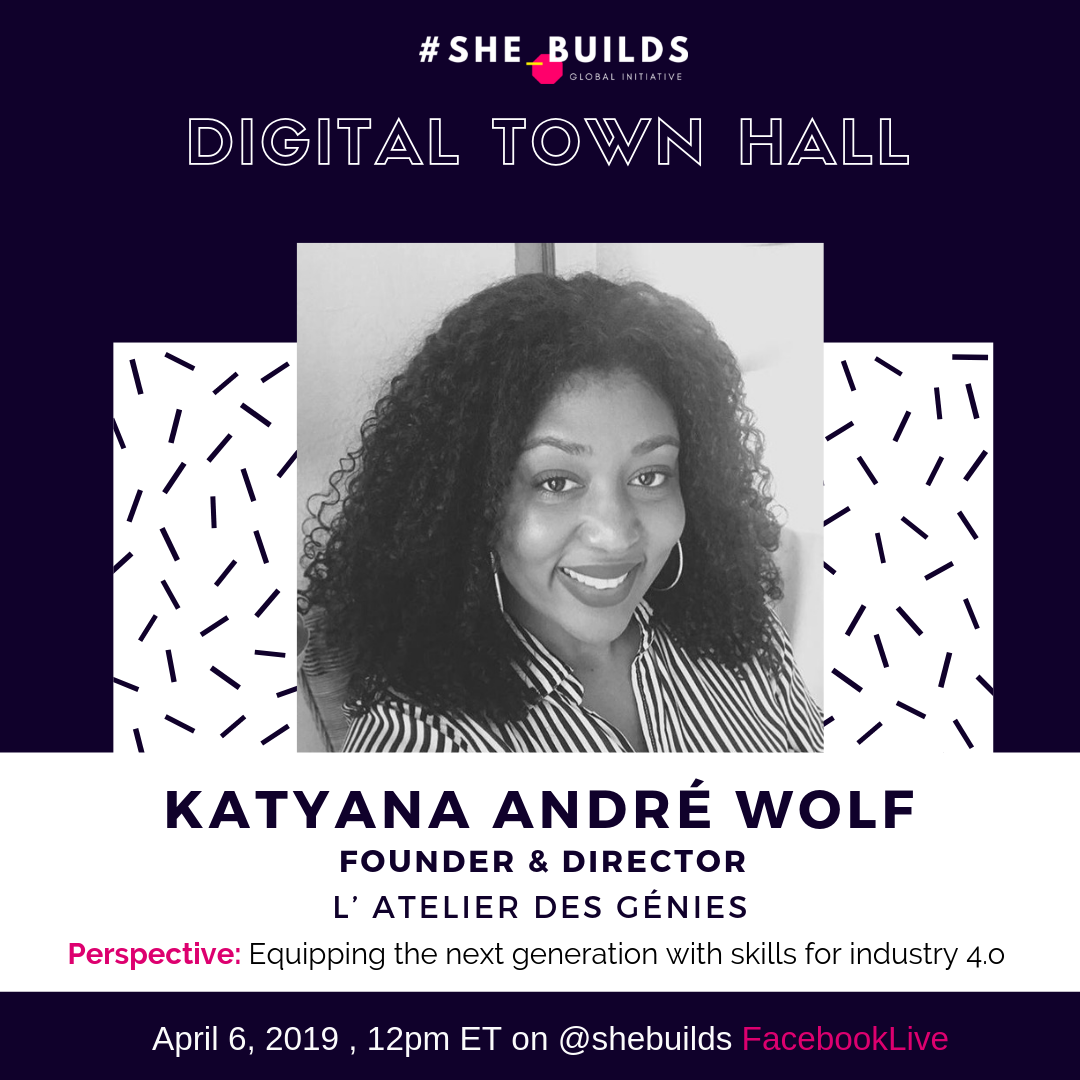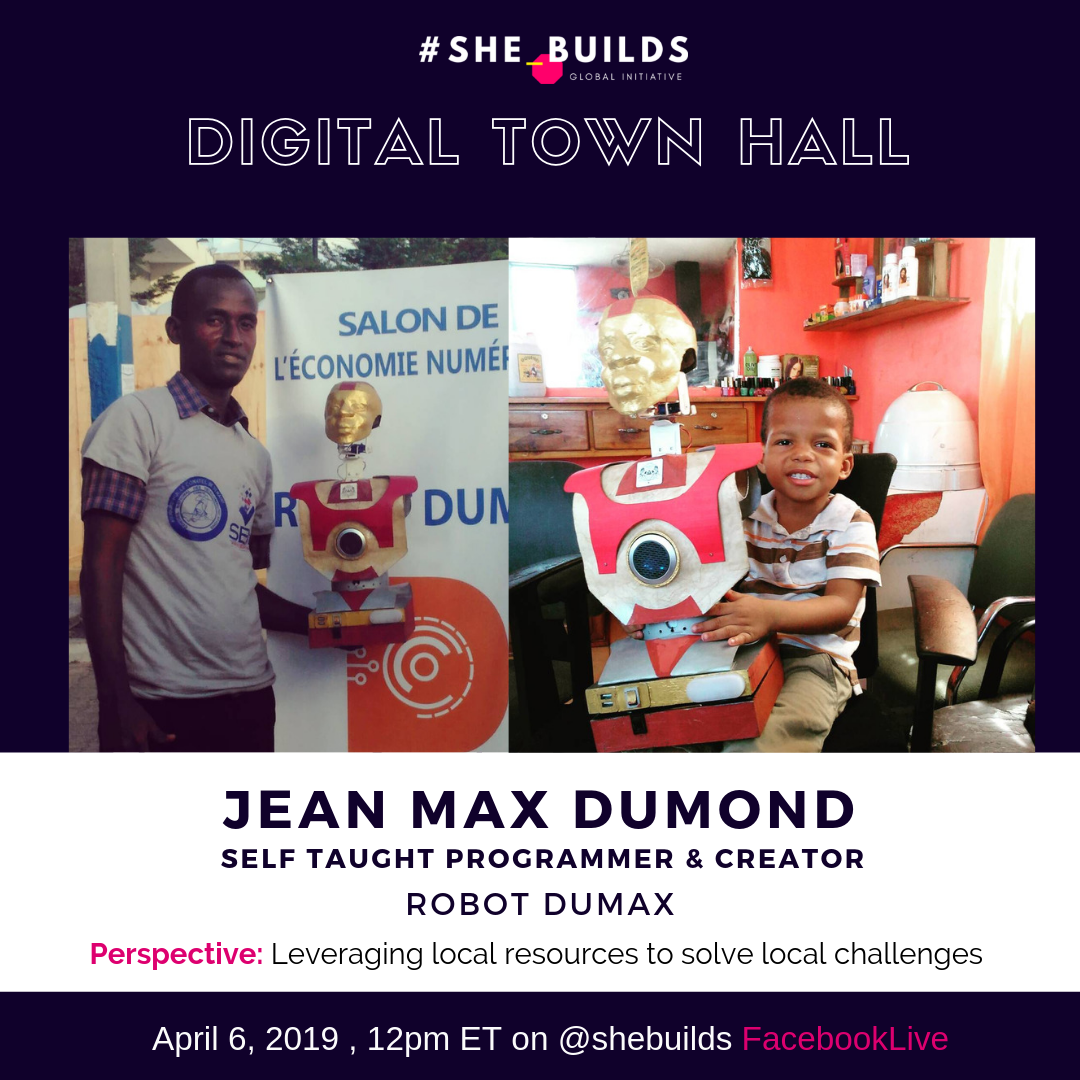[Digital Townhall] Modernizing Local Industries – How Haiti can Leapfrog into the 4th Industrial Revolution
In our 3rd townhall, we explore the topic of modernizing local industries in Haiti, and how Haiti can position itself to leapfrog into the 4th Industrial Revolution.
What does the 4th industrial revolution entail?
What is the impact that it is having on the world today?
What is Haiti doing in this space?
Key Take-aways from our expert panelists:
Zoe Bezpalko | Design & Manufacturing Sustainability Strategy Manager | Autodesk
Perspective: Leapfrogging into Industry 4.0
Zoe Bezpalko works within the smart manufacturing and sustainability space
She leads the strategy for sustainability in design at Autodesk.
Zoe helps the organization reduce their environmental footprint by using technology.
Autodesk is a software development company and their products are used widespread.
The first industrial revolution brought us steam and engines for manufacturing.
The second industrial revolution brought electricity to start powering machines.
The third industrial revolution brought us robots that we use to assemble cars.
The fourth industrial revolution is the internet and the Internet of Things (IoT). IoT brought us the use of cloud technology and machine learning to build smarter technology. We are now capable of building more intelligent and connected systems.
Industrial progress typically has a negative impact on the environment
There are industries creating waste that have a negative impact on the environment.
There are a lot of inefficiencies that create waste.
The Internet of Things used in factories can reduce the energy demand by 25%. You can better manage facilities and bolster productivity.
Increased efficiencies and decreased costs.
Could this industrial revolution widen the digital divide between countries?
The goal is not only to develop the best technology but to make it accessible to all.
Prices are decreasing for most of our products which would make them more accessible.
Autodesk has a foundation that provides free software to nonprofits in developing countries such as Nepal. Each country can take this technology and adapt it to their local environment.
Lessons learned from SE Asia – the idea of bringing design thinking and design strategy. We should not be designing for communities but designing with communities.
What does designing with communities look like?
We provide guidance on the innovation process.
Facilitators can help people identify problems and work with them to design a solution.
Start with a problem. You need people who experience the problems firsthand to properly design with.
The idea of leapfrogging requires guidance. Start with a problem and leverage design thinking strategies. A good place to start is addressing basic needs and basic problems first.
Autodesk Impact Residence Program at Pier 9 in San Francisco
This is a fabrication space where we demonstrate and test the future of manufacturing products.
One attendee from Kenya used his time at the residency to build a machine to bend pipe. He used this technology to address a problem in his country. With the knowledge that he acquired, he can teach others how to replicate the technology on site.
Design with people and really think about their needs. With this mindset, you can build any program or initiative and have a lasting impact.
George Barau Sassine, President | Association des Industries d’Haiti
Perspective: Positioning Haiti’s local industries for global scale
Sassine worked in finance in New York City and returned to Haiti where he began working as a line production supervisor
Under Jean Claude Duvalier, Haiti was expanding in the manufacturing sector. During this administration, Sassine worked to promote and to vet potential investors. That is how the Office National pour la Promotion des Investissements was founded. In 1989, the Associations des Industries was created. Golf clubs, rubik’s cubes, and a host of other industrial products were manufactured in Haiti.
After the embargo, Haiti went from having 200,000 people working in manufacturing to only 9,000.
Sassine was an early promoter of trade not aid.
He lobbied for the passage of the HOPE Act (the Haitian Hemispheric Opportunity for Partnership Encouragement Act of 2006) to give preferential treatment to foreign entities working in Haiti.
He also oversaw the building of Caracol Industrial Park in northern Haiti. Now there are 54,000 people working in the industrial sector (15,000 of whom are at Caracol).
Association des Industries was founded in the early 1980s
They service industries working in the local market and as well as industries who export products (only one company is exporting technology, the rest are exporting garments).
They disseminate information to members organizations.
How did the earthquake affect the manufacturing sector in Haiti?
Local industries and manufacturers were badly hit by the 2010 earthquake. Manufacturers who export goods were not as badly hit.
Sassine wanted companies to reopen immediately after the earthquake to help people’s lives return to a sense of normalcy.
A lot of investments were coming in as Haiti was all over the news. But this money was squandered.
Manufacturers could borrow money at a fixed rate from the Central Bank. This spurred investments in the construction of industrial parks.
A crippling mindset prevented these projects from being really successful.
Are businesses in Haiti using technology in the way that the rest of the developed world is using technology? Are companies exposed to the technologies that are available to them?
Before Digicel, the assumption was that Haiti could not handle 40,000 cell phones, but now there are more than 3 million users. People are using cell phones for wire transfers and for a host of other transactions, in both rural and urban areas.
Cell phones are spreading access to information.
For most companies, pay rolls are on computers, but there has not been rapid uptake of scalability technologies.
For those hoping to enter the manufacturing sector, what challenges can they anticipate?
The opportunities are boundless. Haiti is a virgin country, so everything needs to be done.
The public sector however does not have adequate systems in place to support private sector growth.
What other problems might companies face?
Transportation of workers. At Caracol Industrial Park, there is one factory with 13,000 workers. One of their main problems is transporting workers from their homes to the factory.
The ports cannot support the amount of goods Haiti needs to export.
Health insurance program OFATMA does not provide adequate services to employees.
How is waste management dealt with by manufacturers?
Private sector companies pick up waste and dispose of waste as they please.
There is no solid waste management system.
Can industries currently producing in Haiti supply to the global market?
USAID has a program in place to help farmers export their products. Sanitary systems must adhere to international standards if we want to see Haitian peanut butter and jams in foreign supermarkets.
Assuring consistency of the supply chain.
We export a lot of mangoes. 40% of them are lost in transportation. There is an opportunity to potentially to automate the harvesting and sorting process.
Is there an entity enforcing food and safety regulations in the Haiti? No, there is no acting organization.
Katyana André Wolf, Founder & Director | L’Aterlier des Génies
Perspective : Equipping the next generation with skills for industry 4.0
Aterlier des Génies implements STEM afterschool programs for kids 5-16 years old
They encourage kids to use their creativity in school while practicing their problem solving skills.
Aterlier des Génies is equipping an upcoming generation with skills that are critical for meeting global market demands. Will their skills be relevant to the local job market?
We envision our students going on to become game changers.
With the knowledge and leadership skills that we instill in them, these kids will go on to transform industries in Haiti.
How do you bridge the gap between talent and industry?
Companies should invest in building more training programs. There should be more company-university partnerships to ensure that industries are hiring tech talent locally.
Tech companies like Google do not hire people ready-made. They hire those with potential who they train on the job for 2 months to grow within the company.
Companies should not be afraid to share information. They should try to find ways to implement training programs that all employees can benefit from.
Major solutions summarized:
Companies need to invest in people
Partner with universities
Companies need to invest in training their employees
Companies should be sharing information amongst themselves to ensure that industries across the board are growing together
What would it take for a platform like yours to scale outside of Port-au-Prince?
What we are doing is easily reproducible. You need to foster different ways of thinking and begin to valorize STEM education in the classroom.
Sydney (11 year old coder at Aterlier des Génies) can you tell us about your experience learning to code?
We are building a robot and programming it to make it move.
This has been challenging but I enjoy the challenge.
To young girls out there, I would encourage you to have a problem fixing mindset. You don’t have to use technology to address the problem, but use the tools available at your disposal.
Katyana André, what advice would you give to Haitians in the diaspora who want to do business in Haiti?
Before you decide to be an entrepreneur, do your research.
You must be multi talented. You must be creative. Do your research and talk to people who are currently working in the industry.
Haiti needs the diaspora to come back. If you can make it in Haiti, you can make it anywhere.
We need to look at education, especially the education of young girls in STEM, to help the country advance. This is a sector that is heavily male dominated in Haiti.
Jean Max Dumond, Self Taught Programmer & Creator | Robot Dumax
Perspective: Leveraging local resources to solve local challenges
Jean Max built a robot to address a problem that his son was having
Self taught programmer who created a Robot to solve a major challenge with his child’s speech capabilities. Jean Max taught himself to program in HTML, C ++, and some JavaScript. Within two months, he built his first robot.
Robot Dumax is a conversational robot with a mini-artificial intelligence able to speak and answer questions.
The second prototype is made entirely of recycled material.
How can someone else in Haiti replicate what you did?
First you must be in love with technology. And with this love of technology, you will be better positioned to address problems around you.
Jean Max took the first step to exposing his son technology by teaching him how to draw. He agrees that it is important to have a holistic education, incorporating the arts into STEM (STEAM education).
Youth are Haiti’s future. We need to invest in educating them in mathematics and the arts because they are the ones who will lead the country forward.




